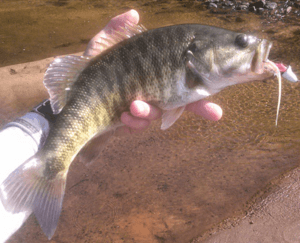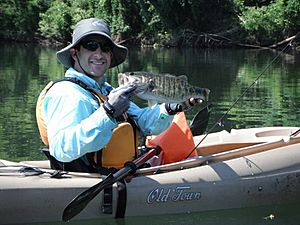Shoal bass facts for kids
Quick facts for kids Shoal bass |
|
|---|---|
 |
|
| Shoal Bass (Micropterus Cataractae) Flint River, GA (released) | |
| Conservation status | |
| Scientific classification |
The shoal bass (Micropterus cataractae) is a cool freshwater fish. It belongs to the sunfish family, just like other black basses. You can find this fish in warm waters in Florida and Georgia. It also lives in some rivers and streams in East Alabama. In Alabama, it's an endangered species, so you can't keep it if you catch one.
Shoal bass are a good size for a black bass. They can grow up to 24 inches (61 cm) long. The heaviest one ever recorded weighed 8 pounds, 12 ounces. Scientists, called ichthyologists, only officially described this fish in 1999. They are still learning new things about it! People sometimes confuse the shoal bass with the redeye bass because of its reddish eyes. It can also look like a smallmouth bass because it has faint stripes on its sides.
Contents
What Does a Shoal Bass Look Like?
Scientists used to think the shoal bass was just a type of redeye bass. But in 1999, they realized it was a completely new species!
At first glance, its red eyes might make you think of the redeye bass or the Suwannee bass. However, the shoal bass is actually more like the spotted bass in its body shape. Shoal bass are usually olive green to almost black on their backs. They have a dark spot on the back edge of their gill cover, which is about half the size of their eye.
Look closely, and you'll see three black lines on the side of its head. These lines look a bit like war paint! They also have 10 to 15 dark blotches along their sides. Sometimes, you can even see tiger-like stripes between these blotches.
The belly of a shoal bass is creamy or white. Wavy lines might appear just above the white belly on its sides. Its top fin, tail fin, and bottom back fin are dark olive green or grayish-black. The fins on its belly might have a cream-colored front edge with dark spots.
The shoal bass has scales on the base of its soft-rayed top fins. Its first and second top fins are clearly connected. Also, its upper jaw bone does not go past its eyes. There are no different types or subspecies of the shoal bass known.
Where Do Shoal Bass Live?
The shoal bass is becoming harder to find in the Apalachicola River and Chipola River. This is because there are fewer rocky areas (called shoals) there. Also, another fish, the non-native spotted bass, is competing with them for food and space.
You can also find shoal bass in the Chattahoochee River area. They are most common in Georgia's Flint River, which doesn't have many dams. They also live in lakes like Blackshear and West Point. Shoal bass really like rocky shoals. They don't often live in other places because they need these specific rocky areas to lay their eggs.
The shoal bass is considered "vulnerable" across the places it lives. This means their numbers are decreasing. Good fishing for shoal bass still exists in Georgia's Flint River. However, anglers (people who fish) are asked to catch and release them. This helps protect the species. On the other hand, anglers are encouraged to keep any spotted bass they catch on the Flint River. This is because spotted bass compete with shoal bass and can even mix with them.
Shoal Bass Life Cycle and Behavior
Shoal bass lay their eggs in April, May, or early June. They choose rough gravel areas at the start of creek pools. They like the water temperature to be between 64 to 79 °F (18 to 26 °C) for spawning. Just like the largemouth bass, the male shoal bass builds the nest. He then guards the eggs and the baby fish (called fry).
Shoal bass mostly eat insects that live on the water's surface. They also eat young insects, crayfish, and smaller fish. Shoal bass grow much faster than redeye bass.
Fishing for Shoal Bass
Shoal bass offer a fun challenge for anglers, just like other black bass species. You can catch them using worms, small fish (minnows), or crayfish. Small spinning lures and many types of small surface lures also work well. Some shoal bass have been caught that weighed more than eight pounds!
When fishing for sport, there are special rules about how many you can keep and how big they must be. In Florida, you can even register a big catch as part of the "Big Catch" program.
The meat of a shoal bass is white and flaky. It tends to be a bit drier than the meat from a largemouth or spotted bass.
The world record shoal bass weighed 8 pounds, 12 ounces. This record was set on October 23, 1977, in the Apalachicola River, Florida. This fish was first thought to be a redeye bass, but it was later confirmed to be a shoal bass.
Shoal bass are also popular for fly fishers. They are easy to find in their favorite river homes. Fishing for shoal bass with a fly rod is becoming more popular.
The shoal bass fights harder than its cousin, the largemouth bass. It also has more energy! They prefer water that moves at a moderate to fast speed. They will aggressively bite lures that look like crawdads. A five-pound shoal bass is considered a great catch. But fish over seven pounds are caught every year!



